Asia
Asia is the largest continent in the world. The Cloud Forests are very strange forests in Asia. They have fog, or clouds, all over them, creating, not only, beautiful landscapes, but also many lost tourists since the eyesight is so bad! The Clouded Leopard, and the Yin Yang Frog both live in a Cloud Forest. While many other animals are from other kinds of forests that are slightly less cloudy.
Proboscis Monkey
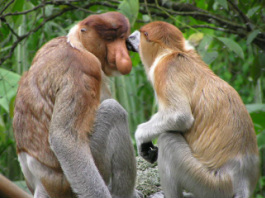
Proboscis means nose in Latin, probably explaining where
they got their names! The reason these monkey's have such
huge noses so that they can make a huge honking sound. Some
of the reasons they use this honking sound is to, A: challenge
males for territory, and B: Attract females, because the louder a
honk is the healthier monkey is.
These monkey's sleep near water for two reasons, they would
be protected from any sneak attacks from behind, and they're also
great swimmers. Proboscis Monkeys are such good swimmers that
they even have webbed feet!
they got their names! The reason these monkey's have such
huge noses so that they can make a huge honking sound. Some
of the reasons they use this honking sound is to, A: challenge
males for territory, and B: Attract females, because the louder a
honk is the healthier monkey is.
These monkey's sleep near water for two reasons, they would
be protected from any sneak attacks from behind, and they're also
great swimmers. Proboscis Monkeys are such good swimmers that
they even have webbed feet!
Panda
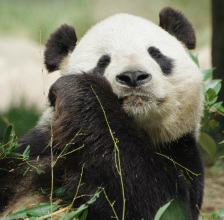
I'm the sure you know who this is...yes it's the panda, much bigger
then the red panda above, but just as endangered. Sometimes I wish
I had the life of a Panda, I mean not the being endangered part, but the
everyday life part, a Panda's life mostly consists of eating, sleeping,
and relaxing in the trees! It's sad to think that us humans are the ones
to interrupt this gentle life of a Panda.
then the red panda above, but just as endangered. Sometimes I wish
I had the life of a Panda, I mean not the being endangered part, but the
everyday life part, a Panda's life mostly consists of eating, sleeping,
and relaxing in the trees! It's sad to think that us humans are the ones
to interrupt this gentle life of a Panda.
Clouded Leopard
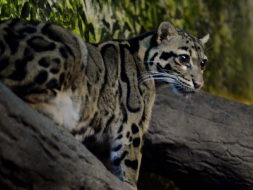
Not much is known about this magnificent animal, and they are pretty
endangered. They are known to live in places from the mountains in
Nepal to the Rain forests in Indonesia. These cats are amazing climbers,
they can hang upside-down off a branch! So it's no surprise that they'd live
in places filled with trees and rocky ledges! Their legs are built for
climbing, they have rotating ankles for a smooth climb down, and short,
yet powerful hind legs, and a long tail to keep their balance. They're kind of
like big squirrels!
endangered. They are known to live in places from the mountains in
Nepal to the Rain forests in Indonesia. These cats are amazing climbers,
they can hang upside-down off a branch! So it's no surprise that they'd live
in places filled with trees and rocky ledges! Their legs are built for
climbing, they have rotating ankles for a smooth climb down, and short,
yet powerful hind legs, and a long tail to keep their balance. They're kind of
like big squirrels!
Orangutan
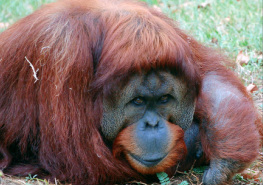
Orangutans are very smart animals, they can swing in the trees with ease,
but you'd think don't orangutans arms get sore? Well the answer is they do,
and to cure this problem, they pick leaves from a plant called Commelina, then
they chew up the leaves making a unique paste and rub it on their arms! As
amazing as they are these magnificent creatures are also endangered even
though they have adapted very well, and are very smart they are also very
endangered.
but you'd think don't orangutans arms get sore? Well the answer is they do,
and to cure this problem, they pick leaves from a plant called Commelina, then
they chew up the leaves making a unique paste and rub it on their arms! As
amazing as they are these magnificent creatures are also endangered even
though they have adapted very well, and are very smart they are also very
endangered.
Draco Lizard
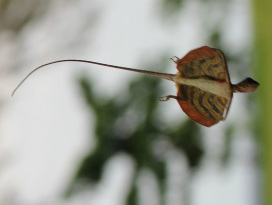
Draco Lizards are Lizards that can glide from tree to tree by extending flaps of
skin in between their arms. The flaps of skin catch the wind, so when they want
to go faster or lower they extend less of their skin flaps, and when they want to
go higher and slower the extend their skin further out.
When the Draco extends it's skin flaps it's ribs pop out with the skin that is
why there are little lines on the skin flaps.
skin in between their arms. The flaps of skin catch the wind, so when they want
to go faster or lower they extend less of their skin flaps, and when they want to
go higher and slower the extend their skin further out.
When the Draco extends it's skin flaps it's ribs pop out with the skin that is
why there are little lines on the skin flaps.
Bengal Tiger
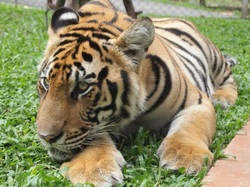
Tigers are large and aggressive, but they usually avoid humans. a tigers
roar can be hear from up to two miles! Tigers are very territorial, they mark
their territory so that their rivals stay far away. After their kids are two-three
years old, even they have to leave their mothers territory and go find their
own. Fathers rarely help the mother take care of their child, and if they do
they help very little.
roar can be hear from up to two miles! Tigers are very territorial, they mark
their territory so that their rivals stay far away. After their kids are two-three
years old, even they have to leave their mothers territory and go find their
own. Fathers rarely help the mother take care of their child, and if they do
they help very little.
Giant Clam

Giant clams can't move once they've picked a home. When giant clams are
born the float off into the ocean's reef then they find a place to call home in
the reef and stay there for the rest of their lives. Now you may be wondering
how Giant Clams have babies if they can't move, well what happens is a Giant
Clam releases a sperm or egg into the ocean until it meets an egg or sperm
and forms an embryo.
Giant Clams are truly giant, they are the largest immobile mollusk known
to humans. giant clams can get up to 6 ft long! Because of their size some
people think that giant clams are responsible for many human deaths, but this
seems unlikely because giant clams aren't actually that aggressive they're
actually very shy and would hide inside their shell if a human was coming,
however they are omnivorous which means they eat both plants and animals.
born the float off into the ocean's reef then they find a place to call home in
the reef and stay there for the rest of their lives. Now you may be wondering
how Giant Clams have babies if they can't move, well what happens is a Giant
Clam releases a sperm or egg into the ocean until it meets an egg or sperm
and forms an embryo.
Giant Clams are truly giant, they are the largest immobile mollusk known
to humans. giant clams can get up to 6 ft long! Because of their size some
people think that giant clams are responsible for many human deaths, but this
seems unlikely because giant clams aren't actually that aggressive they're
actually very shy and would hide inside their shell if a human was coming,
however they are omnivorous which means they eat both plants and animals.
Gharial
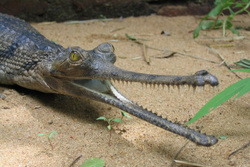
The first thing that stands out when you look at the Gharial is it's snout! Gharials
get this weirdly shaped snout when they're born, but as they get older they're snout
gets shorter, and wider. Gharials are found in rivers in India, and many other middle
east countries. Every December and January starting when they are seven years old a
female will find a male who is at least 18 years old to mate, it is not hard to find a male
because males guard territories where several females live. Gharials are critically
endangered, and they're considered one of the most critically endangered crocodilians
in the world!
get this weirdly shaped snout when they're born, but as they get older they're snout
gets shorter, and wider. Gharials are found in rivers in India, and many other middle
east countries. Every December and January starting when they are seven years old a
female will find a male who is at least 18 years old to mate, it is not hard to find a male
because males guard territories where several females live. Gharials are critically
endangered, and they're considered one of the most critically endangered crocodilians
in the world!
Siamang

Siamangs are the largest gibbons in the world, yet they are pretty small!
Siamangs are slender and have long arms to swing in the trees. Siamangs
are apes, so they don't have tails. Siamangs are also gibbons, but unlike
Gibbons Siamangs have webbing in between their 2nd and 3rd toes. they
have opposable thumbs like most primates, and a hairless face, except for a
small beard at the bottom of their face. Siamangs live in groups consisting of,
a mating male and female, and an offspring less then seven years old. When
an offspring reaches an age above seven they will go find they're own mate, and
start a family. As you can see Siamangs have throat sacs, Males and females
both have these sacs under their chin, which they use to make they're calls louder.
These throat sacs make them the loudest Gibbons in the world (since most other
gibbons don't have these).
Siamangs are slender and have long arms to swing in the trees. Siamangs
are apes, so they don't have tails. Siamangs are also gibbons, but unlike
Gibbons Siamangs have webbing in between their 2nd and 3rd toes. they
have opposable thumbs like most primates, and a hairless face, except for a
small beard at the bottom of their face. Siamangs live in groups consisting of,
a mating male and female, and an offspring less then seven years old. When
an offspring reaches an age above seven they will go find they're own mate, and
start a family. As you can see Siamangs have throat sacs, Males and females
both have these sacs under their chin, which they use to make they're calls louder.
These throat sacs make them the loudest Gibbons in the world (since most other
gibbons don't have these).
Tarsier
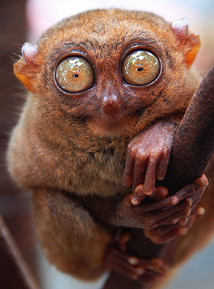
Tarsiers are nocturnal animals from the Philippines. You may be wondering why they
have such huge yellow eyes, since they're nocturnal they need big bright colored eyes
to help them see at night. Tarsiers used to be kept as pets in the Philippines until this
was outlawed because it seemed to stress them when they have to stay awake during
the day instead of the night entertaining their owners. You'd understand why people
wanted them as pets, because they're just so darn cute! Another factor of their cuteness
which may not be seen in this picture is their size, they are smaller then a human hand,
and can fit perfectly into your palm. Since it's so small it usually eats small things like
insects that they find inside trees.
Tarsiers have been endangered from the start. At first they where stuffed and sold
to tourists who wanted a cute stuffed animal for their living rooms, when this was outlawed
you'd think that helped the Tarsiers from becoming extinct, but de-forestation is still helping
the Tarsiers become extinct.
have such huge yellow eyes, since they're nocturnal they need big bright colored eyes
to help them see at night. Tarsiers used to be kept as pets in the Philippines until this
was outlawed because it seemed to stress them when they have to stay awake during
the day instead of the night entertaining their owners. You'd understand why people
wanted them as pets, because they're just so darn cute! Another factor of their cuteness
which may not be seen in this picture is their size, they are smaller then a human hand,
and can fit perfectly into your palm. Since it's so small it usually eats small things like
insects that they find inside trees.
Tarsiers have been endangered from the start. At first they where stuffed and sold
to tourists who wanted a cute stuffed animal for their living rooms, when this was outlawed
you'd think that helped the Tarsiers from becoming extinct, but de-forestation is still helping
the Tarsiers become extinct.
Yak
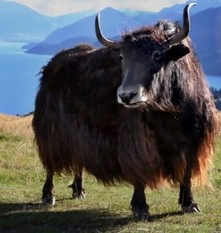
Yaks are often domestic in Tibet. Sometimes Yaks are used for their fur and horns
which has resulted in their name being on the endangered species list. Since Yaks
are vulnerable. Yaks used to live all over the Himalayan mountains, but when humans
realized that they could use the Yaks fur, they started poaching Yaks. Today Yaks can
only be found in the remote Tibetan Plateaus.
which has resulted in their name being on the endangered species list. Since Yaks
are vulnerable. Yaks used to live all over the Himalayan mountains, but when humans
realized that they could use the Yaks fur, they started poaching Yaks. Today Yaks can
only be found in the remote Tibetan Plateaus.
Sun Bear
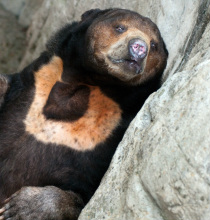
Sun Bears get their names from the bib like patch on their chest which looks sort of
like a rising sun. What you may not be able to tell that it is also very small! They are
the smallest bear in the Bear family. I like to think that since it's the smallest it gets
a baby bib! Sometime this bear is referred to as a dog bear because of its short
muzzle, and small ears.
The Sun Bear's body is perfectly designed for roaming in trees. Sun Bears even
sleep on tree platforms. They make platforms out of leaves and sticks so that they can
sleep high above the ground. Ironically these Bears re nocturnal, and don't stay up while
the sun is up!
like a rising sun. What you may not be able to tell that it is also very small! They are
the smallest bear in the Bear family. I like to think that since it's the smallest it gets
a baby bib! Sometime this bear is referred to as a dog bear because of its short
muzzle, and small ears.
The Sun Bear's body is perfectly designed for roaming in trees. Sun Bears even
sleep on tree platforms. They make platforms out of leaves and sticks so that they can
sleep high above the ground. Ironically these Bears re nocturnal, and don't stay up while
the sun is up!
Asian Elephant
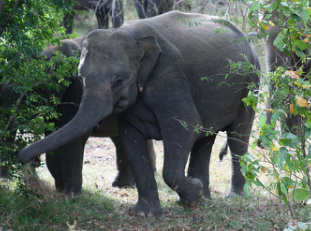
Elephants have over 100000 muscles in their trunk, that's over 100 times as many as a
human's entire body! Elephants can use their trunks in so many different ways like ripping
trees off the ground to shake leaves off, plucking blades of grass of the ground, storing
water to drink, and storing water to throw over their backs for a quick cool off! You may
notice this elephant does not have any tusks next to the trunk. Reason being that,
unfortunately some people illegally kill elephants for the ivory in the tusks. A lot of times
when you see pictures of elephants (African or Asian) they either don't have tusks, or have
really short ones. This is because they usually don't live long enough without being killed to
have such long tusks.
human's entire body! Elephants can use their trunks in so many different ways like ripping
trees off the ground to shake leaves off, plucking blades of grass of the ground, storing
water to drink, and storing water to throw over their backs for a quick cool off! You may
notice this elephant does not have any tusks next to the trunk. Reason being that,
unfortunately some people illegally kill elephants for the ivory in the tusks. A lot of times
when you see pictures of elephants (African or Asian) they either don't have tusks, or have
really short ones. This is because they usually don't live long enough without being killed to
have such long tusks.
Subterranean Blind Fish
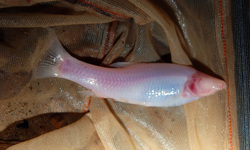
As you may be able to tell from it's name, this fish is blind. It can be found in the
Mekong river in Laos. This river runs mostly underground. Because of this
underground environment the fish is blind, it wouldn't have much to see if it could
anyway! While some fish live in the dark of the ocean, this fish lives in rivers, Life
in the rivers may never be something humans can fully experience living in total
darkness, but this little guy certainly has!
Mekong river in Laos. This river runs mostly underground. Because of this
underground environment the fish is blind, it wouldn't have much to see if it could
anyway! While some fish live in the dark of the ocean, this fish lives in rivers, Life
in the rivers may never be something humans can fully experience living in total
darkness, but this little guy certainly has!
Yin Yang Frog
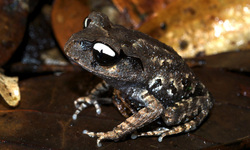
The first thing you might notice about this frog is that it has a very strangely shaped
glare shining on it's eyes from the sun. The reason it has this strange glare is because,
it is actually part of the frogs eyes! hence 'Yin Yang' in its name. This frog is about 1.5
inches long, and an be found in wetland in southern Vietnam. In addition to wetlands this
peculiar little fellow has also been found in cloud forests in southern Vietnam.
glare shining on it's eyes from the sun. The reason it has this strange glare is because,
it is actually part of the frogs eyes! hence 'Yin Yang' in its name. This frog is about 1.5
inches long, and an be found in wetland in southern Vietnam. In addition to wetlands this
peculiar little fellow has also been found in cloud forests in southern Vietnam.
Tree Kangaroo

Tree Kangaroos really do live up to their names! They may not look like it, but they are actually
very agile, they can jump from one tree limb to another, and they can jump to the grown from
an 18 meter height without bruising a single bone! Unfortunately their biggest threats are
humans, humans, and more humans. Due to over hunting and deforestation these little guys have
had a pretty tough time in the forest. Fortunately a hunting ban that was placed in 2004 has
increased their population by 50%!
very agile, they can jump from one tree limb to another, and they can jump to the grown from
an 18 meter height without bruising a single bone! Unfortunately their biggest threats are
humans, humans, and more humans. Due to over hunting and deforestation these little guys have
had a pretty tough time in the forest. Fortunately a hunting ban that was placed in 2004 has
increased their population by 50%!
Slender Loris
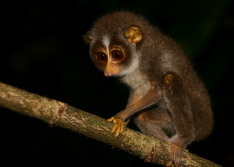
The Slender Loris is a small Sri Lankan and South Indian nocturnal animal. They can live
in wet or in dry forests, but they prefer thick thorny forests where they can escape from predators
easily. They incredibly small, about the size of a chipmunk in fact. Their arms and legs are about
as thin as pencils. Although they do not hunt or live together, sometimes they will hunt in pairs,
and then at the end of the night a bunch of them with come together and share their food. Their food
consists of insects and slugs and other kinds of bugs. Although they are tiny native people believe
that all parts of their body can be used in medicine, and even for magical purposes.
in wet or in dry forests, but they prefer thick thorny forests where they can escape from predators
easily. They incredibly small, about the size of a chipmunk in fact. Their arms and legs are about
as thin as pencils. Although they do not hunt or live together, sometimes they will hunt in pairs,
and then at the end of the night a bunch of them with come together and share their food. Their food
consists of insects and slugs and other kinds of bugs. Although they are tiny native people believe
that all parts of their body can be used in medicine, and even for magical purposes.
Komodo Dragon
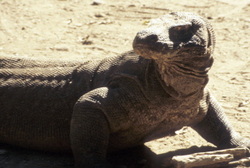
The first Komodo Dragon to be born outside of Indonesia was born in captivity, at the Smithsonian
national zoo. It is now the largest lizard in the world, and before 1992 it only lived in Indonesia. Now
you can find them at zoos outside of Indonesia, but if you want to see a wild one (which I do not
recommend!) You are going to have to take a trip to Indonesia (unless you already live there!) You
may be wondering where the word "Komodo" came from, and it actually came from one of the islands
it inhabits in Indonesia the island of, "Komodo" This animal is also known as the Komodo monitor
sometimes, but as you can see, they sticked with the word Komodo!
national zoo. It is now the largest lizard in the world, and before 1992 it only lived in Indonesia. Now
you can find them at zoos outside of Indonesia, but if you want to see a wild one (which I do not
recommend!) You are going to have to take a trip to Indonesia (unless you already live there!) You
may be wondering where the word "Komodo" came from, and it actually came from one of the islands
it inhabits in Indonesia the island of, "Komodo" This animal is also known as the Komodo monitor
sometimes, but as you can see, they sticked with the word Komodo!









